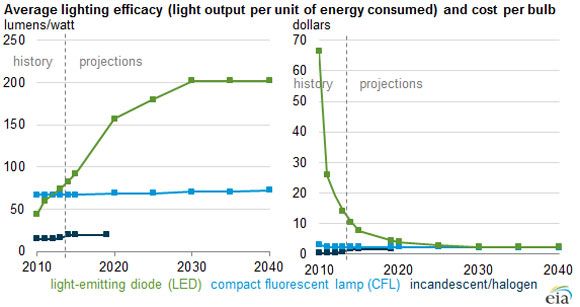Price wars among various consumer light-emitting diodes (LEDs) have been going on for the past year. Soon the price competition will spread not only to compact fluorescents but also incandescents, which are being phased out due to energy efficiency regulations enacted in 2007.
New data from the U.S. Energy Information Administration shows how far the cost of LEDs has fallen since 2010. The agency projects that the technology will approach price parity with CFLs and incandescent bulbs around the end of the decade.
A 2012 report from the U.S. Department of Energy, however, forecasts that LEDs will make up only 36 percent of lumen-hour sales in the lighting market in 2020, a figure that is expected to grow to 74 percent by 2030.
But the DOE has already revised its projections upward three times in the past five years, as it noted in a solid-state lighting report this January. The department now has a goal of 224 lumens per watt efficacy at $0.70 per thousand lumens by 2020 for warm white LED bulbs. EIA’s projections would suggest that this is too ambitious a goal to achieve by 2020 in terms of lumens per watt; its forecast is closer to 150 lumens per watt by 2020.

Between now and 2020, utility rebates will continue to be an important driver for customers who are wary of spending more than they have to on light bulbs, even if the bulbs last longer and reduce energy use. “You cannot discount the effect of rebates on LED lamps right now; without them, the shelf prices are much higher than CFLs,” said Jon Guerster, CEO of Groom Energy.
Cree recently introduced a 100-watt-equivalent LED for under $20; it also has a 40-watt-equivalent warm-white LED on offer for less than $10. Some other incumbents are currently relying on rebates to bring their bulbs down to similar price points.
One recent change, according to Guerster, is that consumers have started to realize that LEDs are the future of lighting (reports of consumers hoarding incandescents notwithstanding). Also, many consumers have expressed dissatisfaction with the light quality of CFLs, and so efficiency-minded individuals are interested in exploring LEDs, even if they cost a few dollars more.
Even so, “rebates will need to continue to support the next wave of growth over the next twelve to 36 months as costs come down further,” he added.



